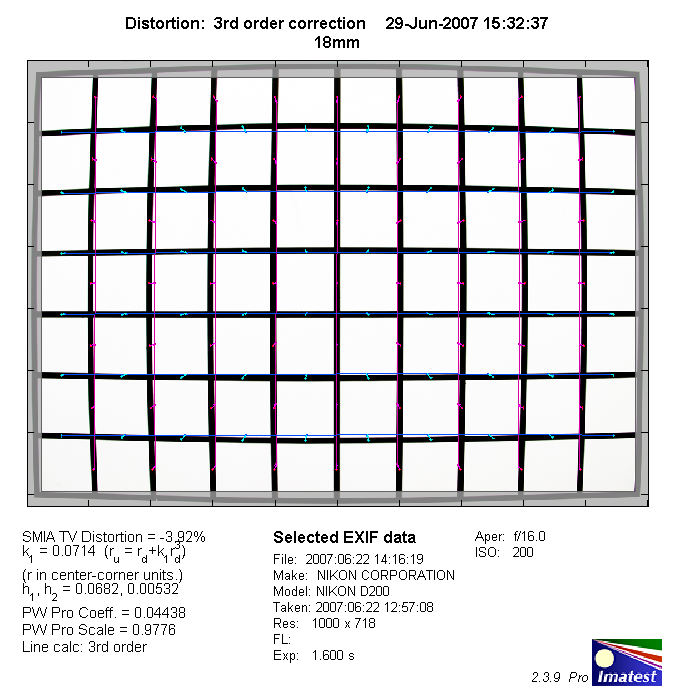|
Tamron AF 18-250mm f/3.5-6.3 Di II LD Aspherical [IF] macro (Nikon) - Review / Lab Test Report - Analysis |
|
Lens Reviews -
Nikon / Nikkor (APS-C)
|
|
Page 2 of 2
Distortion
Typical for extreme range zooms the Tamron exhibits a fairly hefty amount of barrel
distortion at 18mm (~4.9%). However, beyond the wide end the problem is actually
very well controlled with only slight to moderate pincushion distortion.
|
Move the mouse cursor over the focal length text marks below to observe the respective distortion
|
| 18mm |
35mm |
80mm |
135mm |
250mm |

|
The chart above has a real-world size of about 120x80cm.
Vignetting
The Tamron is a dedicated APS-C lens and on the Nikon D200 it shows its fair share
of vignetting especially towards the wide-end of the zoom range (~1.6EV at 18mm @ f/3.5).
Stopped down and beyond 18mm the problem is relatively well controlled for such a lens.

Interestingly the vignetting is much more pronounced compared to the Canon variant of the
lens - the difference between a 1.5x and 1.6x crop is fairly obvious here.
Here're two vignetting examples (Nikon variant):
| 18mm @ f/3.5 | 250mm @ f/6.3 |
 |  |
MTF (resolution)
So far the league of the extreme range zoom lenses didn't really shine regarding
their resolution characteristic but surprisingly the Tamron designers did a pretty
good job here. In the 18-80mm range the center performance is generally excellent
and the borders are on a very good level. The extreme corners are slightly weaker
at 18mm @ f/3.5. There's a continuous drop in resolution towards
the long end of the range. At 135mm @ f/6 and 250mm @ f/6.3 the center is still very
good but the borders start to soften a bit and the overall contrast level is also
somewhat reduced. Stopping down to f/8 boosts the quality to very good figures again.
Please note that the MTF results are not directly comparable across the different systems!
Below is a simplified summary of the formal findings. The chart shows line widths per picture height (LW/PH) which can be taken as a measure for sharpness.
If you want to know more about the MTF50 figures you may check out the corresponding Imatest Explanations
Chromatic Aberrations (CAs)
For most of the zoom range CAs (color shadows at harsh contrast transitions) are fairly
well controlled (for such a lens) with an average pixel width between 1px to 1.5px at
the image borders. At 250mm the problem gets more pronounced peaking near 2px at f/8.

Sample Images
The weather conditions have been miserable during the time of the testing so I'm afraid
that I can't provide you with real world sample shots taken with the D200. However, you may
check out the review of the Canon variant
for this.
Verdict
Early user comments already suggested that new Tamron AF 18-250mm f/3.5-6.3 Di II LD Aspherical [IF] macro
does not only offer a longer range but also a higher quality over the old Tamron AF 18-200mm XR and the
lab results confirm these impressions. The results may not touch the sky but the new AF 18-250mm
delivers a very solid performance for most of the range. Unsurprisingly the weak spot is at 250mm @ f/6.3 -
stopping down to f/8 is a good idea here. Nonetheless the resolution characteristic is fairly amazing
regarding the extreme zoom range. Typical for such lenses the Tamron exhibits a quite extreme level of barrel
distortions at 18mm but at longer focal lengths to the problem isn't overly significant.
Vignetting is a problem at 18mm f/3.5 and in critical situations you should generally stop down
a bit. Lateral CAs (color shadows at the image borders) are on a medium level except at
250mm where the problem can get more disturbing. As to be expected for a zoom lens in this price league
(<450€/US$) the lens body is mostly made of plastic but the build quality is fairly decent.
The AF speed is quite slow on the D200 whereas the AF accuracy is generally fine here.
All-in-all the Tamron is a decent all-round/travel zoom lens. Just make sure that you can live with
its rather slow max. aperture at the long end which requires quite a bit of light or high ISO settings
for stable hand-held photography.
|